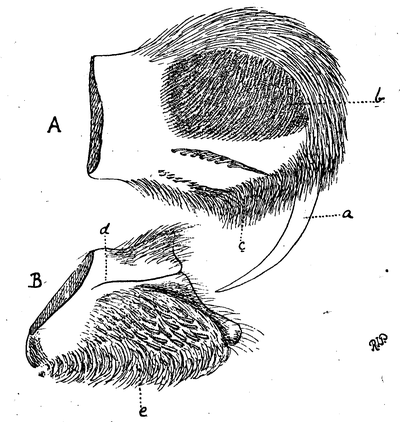adjacent hairs of the oral fringe, being longer and more bristle-like, as, for example, in H. tigrina. These two rows of bristles are evidently designed to catch against and shake the tips of the long feathery bristles which rise up amongst the hairs clothing the area upon the maxilla between the suture (Fig. 1, B, d) and the oral fringe (B, e).

Fig. 1.—Stridulating organ of Harpactira chrysogaster.
A. Outer surface of mandible, showing a, fang; b, pad of feathery hairs; c, oral fringe and two rows of modified bristles between the pad and the fringe.
B. Inner surface of maxilla, showing the cluster of plumose bristles between the suture d and the oral fringe e.
Structurally, this organ, characteristic of Harpactira, calls to mind the organ possessed by the Oriental genera Citharognathus, Phormingochilus, &c. In these, too, the outer surface of the mandible is furnished with a pad of feathery hairs, and the notes or vibrating bristles are also plumose; they are not, however, situated on the maxilla, as in Harpactira, but upon the mandible, and result merely from the enlargement of a few of the hairs of the feathery pad.
The next organ to be described, though resembling the others in principle, differs entirely in position. Instead of being lodged
